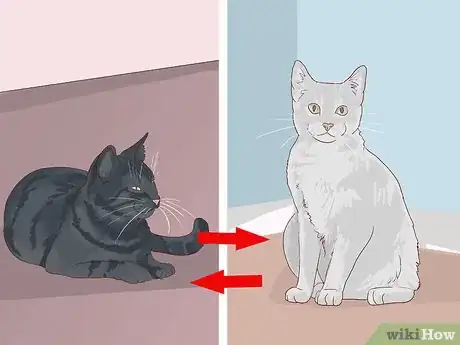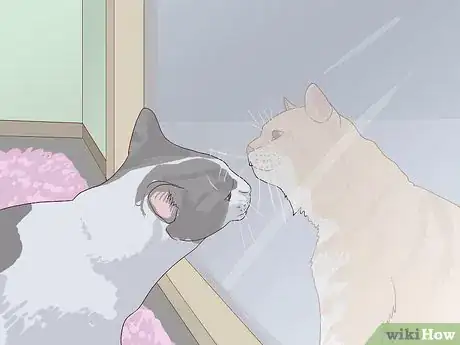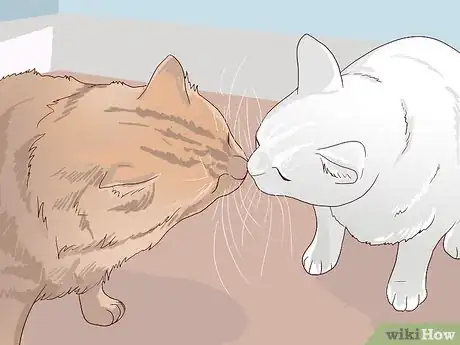This article was co-authored by Jessica Char. Jessica Char is a Cat and Dog Trainer, Behavior Consultant, and the Founder of Feline Engineering and Canine Engineering. She specializes in modifying challenging pet behavior problems, such as fear and aggression, using positive reinforcement training protocols. Jessica is a Certified Fear Free Trainer, a Certified Professional Dog Trainer, and a Certified Separation Anxiety Trainer. She is also a member of the International Association of Animal Behavior Consultants. Jessica received her BS and MS in Biomedical Engineering from Washington University in St. Louis.
There are 7 references cited in this article, which can be found at the bottom of the page.
This article has been viewed 53,734 times.
Getting a new cat can be an exciting experience. However, if you already have cats in your home, you want to manage introductions slowly. It's important that both cats feel secure during the introduction period. Separate your cats initially and allow them to interact through the door. As your cats become more comfortable with one another, have supervised face to face interactions. If there's any tension, take steps to make sure each cat feels it has its own space.
Steps
Separating the Cats Initially
-
1Begin with a confinement period. Never allow two cats to interact face to face right away. Cats are territorial by nature. Your current cat will not react well if you simply introduce a new cat into its territory. Begin the introduction process with a period of confinement.[1] [2]
- Choose a small room to keep the new cat. Make sure the cat has all the essential, such as food, a litter box, a scratching post, and so on.
- At first, keep the new cat's food, water, and other things away from the door. Interacting through the door can help the cats get used to each other, but you should not encourage too much interaction right away.
-
2Trade items between the cats. Cats learn to recognize other animals through scents and pheromones. In order to ease both cats into knowing a new animal, swap toys and bedding. The transition will go smoother if each cat is used to the other cat's scent.[3] [4]
- For best results, go for items you've seen each cat rubbing up against or nuzzling.
Advertisement -
3Encourage the cats to interact through the door. After a few days, you can begin allowing the cats to interact through the doors. Play with each cat near the door. Move bedding, toys, food, and water closer to the door.
- The cats may be standoffish and nervous at first, but be persistent. You want the cat to gradually get used to the other animal.
- You may see your cats pawing at one another through the door. As long as there is no hissing, this can be seen as a form of play.
-
4Switch out the cats. After two to three days of interaction through the doors, switch the cats between confinement areas. Let the new cat explore the house while the old cats are placed in the confinement area. This will get your new cat used to its new home and allow the other cats to get used to the new cat's scent.[5]
- Switch out the cats several times a day for a few days.
- Make sure you only let the new cat roam around the house when you are home to supervise.
Managing Face-to-Face Introductions
-
1Allow the cats to look at one another. If it's possible, let the cats look at each other before interacting. You can place a screen door between the confinement area and the rest of your home. You can also let the cats take a peak at one another with the door cracked open slightly.
- While this can certainly help with a smooth interaction, it may not always be possible depending on your home's set up. If you can't do this step, simply proceed to the next step.
-
2Have the cats meet. Only take this step if all the cats seem calm. All your cats should be eating, drinking, and using the litter box as normal. If your cats aren't showing signs of distress, you can let everyone meet face to face.[6] How long this will take depends on the temperament of your cats.[7]
- You can never quite predict how an interaction will go. Best case scenario, all the cats will act normal after inspecting the new household member.
- There may be some hissing and scratching. However, there is usually no need to intervene. Animals can often work out such conflicts amongst themselves.
-
3Break up conflicts promptly. In the event a serious fight breaks out, you should step in. You do not want any of your cats to get hurt during the introduction process.[8]
- Flattened ears, growling, spitting, and crouching are all signs a cat is becoming very aggressive.[9] If you notice any of your cats behaving in this way, find a way to distract them. Clap your hands or throw something like a pillow near the cat to distract it.
- Herd your cats to separate parts of the house if the aggression does not taper off after distracting your cat.
-
4Separate the cats when they're alone at first. Even if the introduction goes smoothly, keep the cats separate for the first few weeks when you're not home. A new cat will disrupt the balance of your household. Territorial disputes, or fights over food and toys, could break out when you're not home to intervene. Make sure all your cats have a chance to calm down with the new household member before leaving them alone together.[10]
-
5Ask your vet about using Feliway to calm your cats. Feliway is a synthetic cat pheromone that can reduce tension between your cats by helping them to relax and feel secure. You can plug a Feliway diffuser into a wall socket near your cats, or use a spritz furniture with a spray.[11] Don't spray your cats directly.[12]
- Feliway is a man-made version of the pheromone that a mother cat releases naturally to help her kittens feel safe.
Overcoming Common Issues
-
1Choose the right cat. When selecting a new cat for your home, make sure you make the right choice. An aggressive cat, or one with existing behavioral issues, may not do well with other cats.[13]
- When selecting an adult cat, make sure it's lived with other cats before. A cat that's used to being an only child may never adjust to living with other animals.
- Ask at the pet store or shelter if a cat you're considering has any aggressive tendencies or behavioral issues.
- Kittens can usually adapt to situations quicker, especially if they're still very young at the time of the adoption.
-
2Take steps to reduce tension. You can make the introduction smoother by making sure each cat has its own space. This will reduce territorial disputes between your cats.[14]
- Provide places in your home, such as kitty condos and boxes, where your cats can find privacy if necessary.
- Make sure there are enough beds and toys to go around.
- Strive for one litter box per cat, plus one extra to prevent territorial fights.
-
3Give your old cats special attention. Cats that are already in the household need to feel secure when a new cat arrives. Make sure to spend time petting and playing with your old cats each day. This way, they will feel less threatened by the presence of a new cat.[15]
-
4Restart the introduction process if necessary. If the first meeting goes very poorly, start the introduction process from the beginning. While this can be time consuming, it will help cats recover from a poor initial introduction.[16]
- In rare cases, some cats simply will not get along. If this is the case, you may have to find your new cat another home.
Warnings
- If your cat doesn't get along with other animals, it may be a bad idea to bring a new cat into the home.⧼thumbs_response⧽
References
- ↑ Jessica Char. Cat & Dog Behaviorist.
- ↑ http://www.humanesociety.org/animals/cats/tips/introducing_new_cat.html
- ↑ Jessica Char. Cat & Dog Behaviorist.
- ↑ http://bestfriends.org/resources/introducing-new-cat
- ↑ http://www.humanesociety.org/animals/cats/tips/introducing_new_cat.html
- ↑ Jessica Char. Cat & Dog Behaviorist.
- ↑ http://www.americanhumane.org/fact-sheet/introducing-cats-to-cats/
- ↑ http://www.humanesociety.org/animals/cats/tips/introducing_new_cat.html
- ↑ Jessica Char. Cat & Dog Behaviorist.
- ↑ http://www.americanhumane.org/fact-sheet/introducing-cats-to-cats/
- ↑ https://www.youtube.com/watch?v=_8yDUgTVpsU&feature=youtu.be&t=6s
- ↑ https://www.youtube.com/watch?v=y7kkDm-j0vI&feature=youtu.be&t=22s
- ↑ http://www.humanesociety.org/animals/cats/tips/introducing_new_cat.html
- ↑ http://www.humanesociety.org/animals/cats/tips/introducing_new_cat.html
- ↑ https://www.animalhumanesociety.org/training/adding-new-cat-your-household
- ↑ http://www.humanesociety.org/animals/cats/tips/introducing_new_cat.html
About This Article
To introduce a new cat to other cats, start by putting the new cat in a small room by itself. Next, place its food and water dish by the door, which will encourage the old and new cats to smell each other. Additionally, swap bedding and toys between the cats and, after a few days, move the cats’ bedding and toys near the door, encouraging them to interact a little. Then, try putting the established cat in the small room and taking the new cat into the rest of the house, switching them out several times a day for a few days. Finally, allow the cats to meet each other. To learn how to use cat pheromones to calm your cats while they're meeting each other, keep reading!







































































